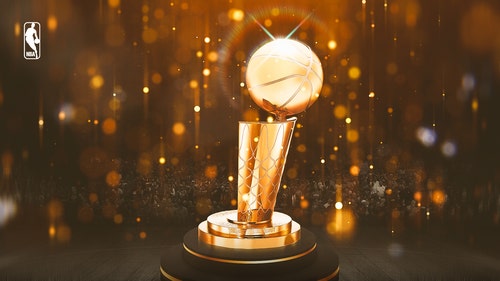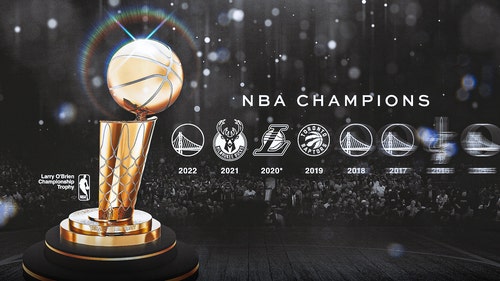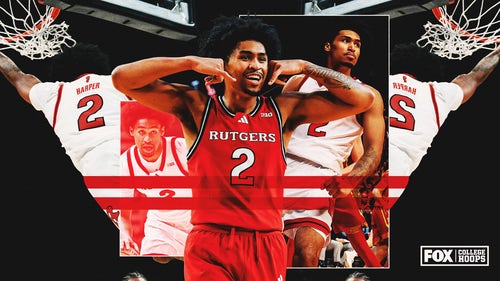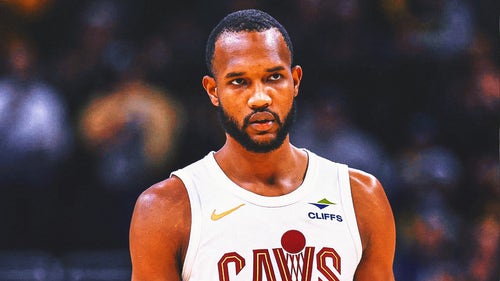
5 ways Allen Iverson was a trendsetter
UNITED STATES – NOVEMBER 17: Philadelphia 76ers’ Allan Iverson on court during game against the New Jersey Nets at Continental Airlines Arena. Iverson scored 28 points in the game, which the Nets lost, 94-82. (Photo by Howard Earl Simmons/NY Daily News Archive via Getty Images)
Allen Iverson enters the Basketball Hall of Fame as part of the 2016 class of inductees. He was one of the most influential NBA players of the 2000s. Here are five ways he was ahead of his time.
Philadelphia 76ers star Allen Iverson will enter the Naismith Memorial Basketball Hall of Fame on Friday night, along with Shaquille O’Neal and Yao Ming as part of the 2016 class of inductees. Iverson was an 11-time NBA All-Star, four-time scoring champion, three-time All-NBA first teamer, and the 2001 NBA MVP.
Iverson had his No. 3 jersey retired by the 76ers, finishing his 14-year NBA career with 24,368 career points, 5,624 career assists, and 3,394 rebounds at 6-0, 165 pounds. It wasn’t just his terrific play on the hardwood in the 2000s that set Iverson apart, it was ability to set trends in the NBA and in basketball culture. Here are the five biggest impacts Iverson left on the NBA as a star for the 76ers and Denver Nuggets.
DENVER – DECEMBER 26: Allen Iverson
5. The shooting sleeve
During Iverson’s 2000-01 MVP season with Philadelphia, he began wearing a compression sleeve on his right arm. He was recovering from bursitis in his right elbow and this shooting sleeve helped him lead the league in scoring, en route to getting the 76ers to the 2001 NBA Finals.
Iverson was having the best year of his NBA career in 2000-01 and basketball fans became accustomed to him wearing the shooting sleeve. Players like Carmelo Anthony and Kobe Bryant started wearing compression sleeves on their shooting arms when dealing with similar injuries in the years to follow.
Not only did the shooting sleeve aid in Iverson’s recovery, it gradually became a fashion statement still used in the NBA today. Players will often wear shooting sleeves either to look cool or to provide mental support. For many, the shooting sleeve acts as a placebo much like braces do on other parts of the body.
Before Iverson started wearing the shooting sleeve, nobody would ever consider putting more than a wristband on their shooting arm. Shooting sleeves eventually progressed into players wearing full-leg compression pants. Players are more comfortable with wearing exposed compression clothing, as it is the new norm in the NBA thanks to Iverson rocking a shooting sleeve in 2000-01.
PHILADELPHIA, UNITED STATES: Philadelphia 76ers Allen Iverson (L) and Eric Snow (R) talk during the second quarter of game four of the NBA Finals 13 June, 2001 at First Union Center in Philadelphia, PA. The Lakers lead the best-of-seven game series 2-1. AFP PHOTO/Jeff HAYNES (Photo credit should read JEFF HAYNES/AFP/Getty Images)
4. Off-ball point guard
When Iverson went No. 1 to the 76ers in the 1996 NBA Draft, he was considered the point guard savior for a terrible Philadelphia team. His personality and competitive drive made him a hit in Philadelphia immediately. The only problem was that his style of play didn’t always make teammates better.
Iverson often focused on scoring because, frankly, he was the 76ers’ best scoring option on every play. The former high school standout at quarterback could drop dimes with the best of the point guards in the NBA, but needed to score at a high rate to give Philadelphia its best chance of winning.
Perhaps the best thing to happen to Iverson in his NBA career was the arrival of Eric Snow in 1998 from the Seattle SuperSonics. Snow played the more traditional role of point guard with Iverson sliding over to the two. Snow would run the offense with Iverson opening up the floor with him as an off-ball scoring guard. Snow’s size and defensive ability allowed him to defend opposing shooting guards which made the arrangement work at the other end as well.
Iverson’s play as an off-ball point guard gave way to great NBA players today like the Houston Rockets’ James Harden. Harden could run the point for the Rockets, but it better serves Houston for him to play off-ball with Patrick Beverley bring the ball up court.
Ball-dominant point guards can hurt teams significantly. By being cool with playing off the ball, Iverson paved the way for a new type of guard to thrive in the NBA: the facilitating scoring guard. Iverson was the prototype for players like Harden to succeed in the modern NBA.
PHILADELPHIA, UNITED STATES: Chicago Bulls Michael Jordan (R) reacts as Philadelphia 76ers Allen Iverson goes up to the basket for two points in the game 15 January in Philadelphia, PA. Iverson’s 31 points led the 76ers in their 106-96 upset of the world champion Bulls. AFP PHOTO TOM MIHALEK (Photo credit should read TOM MIHALEK/AFP/Getty Images)
3. The crossover on Michael Jordan
Iverson’s best NBA season came in 2000-01, but his signature moment as a professional came in his rookie season back in 1996-97 — the crossover on Michael Jordan of the defending champion Chicago Bulls.
Though it would take Iverson four more years to take over the NBA, his crossover on Jordan ushered in a new style of play in the NBA. Jordan was an elite defensive player and rarely bit on the flashy moves of the best ball-handlers in the game.
As a 21-year-old rookie, Iverson briefly embarrassed the best player in the NBA in a shocking win against the 55-8 Bulls. That crossover made it cool to be an elite ball handler. To that point, it had been all about scoring in the Jordan era of the NBA.
Kids across the United States would focus on dribbling drills to be like Iverson, instead of like Jordan. The 2000s would be a time that flashy ball-handling would be commonplace in the NBA. Iverson didn’t live and die on elite dribbling, but his crossover of Jordan gave way to players that strongly emphasized that part of their game.
May 23, 2012; Philadelphia, PA USA; Philadelphia 76ers former guard Allen Iverson before the start of game six against the Boston Celtics in the Eastern Conference semifinals of the 2012 NBA Playoffs at the Wells Fargo Center. Mandatory Credit: Eric Hartline-USA TODAY Sports
2. Brought hip-hop culture to mainstream NBA
Under commissioner David Stern, the NBA sought to be as mainstream as possible. Stern wisely marketed the players over the teams, witnessing fantastic growth in the Association from the mid-1980s to the mid-2010s.
Part of the NBA bringing basketball to the mainstream was to present its players in a manner that could appeal to middle America. That makes sense, as the Midwest loves basketball and the suburbs have families that can afford high-priced tickets. The problem was that this marketing tactic didn’t accurately represent all hoop heads across the United States.
Iverson was never going to pander to what the media or the NBA wanted. He was unapologetically himself, almost to a fault. Iverson was the catalyst that brought hip-hop culture to the NBA and ultimately helped move it into the mainstream. The cornrows, the tattoos, and the attitude Iverson displayed forever changed the social norm of the NBA.
Star players after Iverson didn’t have to look ultra-conservative to be adored by fans of the NBA. Iverson’s popularity as a player allowed the NBA to embrace hip-hop culture and new marketing demographics more than ever before. The league’s popularity domestically in the 2000s was largely attributed to the polarizing star that was Iverson.
Mar 20, 2015; Oakland, CA, USA; Golden State Warriors guard Stephen Curry (30) replace his mouth piece during the third quarter against the New Orleans Pelicansvat Oracle Arena. Golden State Warriors won 112-96. Mandatory Credit: Bob Stanton-USA TODAY Sports
1. Gave small guys hope in modern NBA
There’s no way that Iverson could have realized this during his playing days, but his diminutive stature, his great relationship with young fans, and his fearlessness to compete gave small guys the hope that one day they could play in the NBA. In many ways, he was a transition point between the league being dominated by giants like Shaquille O’Neal and Yao Ming, and the modern era where shooting, speed, and dribble penetration are king.
Iverson was barely six-feet tall and 165 pounds soaking wet, yet he feverishly attacked the rim against opponents 50+ pounds and half a foot taller than him. He was slightly bigger than an average adult male, but was an inspiration for other guys that were told they’re too short to keep on playing anyway.
Two players are helping carry that legacy today: Boston Celtics point guard Isaiah Thomas, and Golden State Warriors point guard Stephen Curry.
Thomas is maybe 5’10”, but that didn’t stop him from being an All-Star in his first full season with the Boston Celtics in 2015-16.
Then there’s Curry. Curry is slight of built at 6’3″, 190 pounds, but is one of the three best players in the game today with new Warriors teammate Kevin Durant and the Cleveland Cavaliers’ LeBron James.
Though Curry’s game features a three-point stroke that Iverson never had, Curry isn’t afraid to attack the rim at the point. Iverson’s game influenced Curry’s and Curry’s is changing how America’s youth plays basketball with every clutch three-pointer he drains.
More from FanSided
This article originally appeared on











